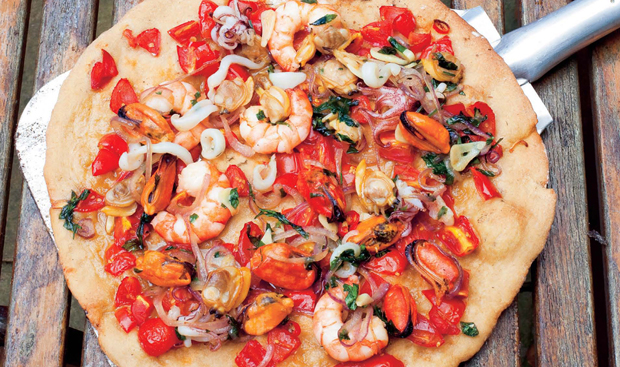
A slice of history: the American angle on traditional Italian pizza
Bonnie Tsui investigates what constitutes a true pizza and why it's lovingly thought of as a national dish in the States
One of the most distinctive food memories I have from my childhood growing up in Long Island, New York involves strolling into a local pizzeria and ordering a slice of baked-ziti pizza: a crispy-edged yet chewy-crusted pie loaded with oregano-flecked red sauce, a layer of cooked tubular pasta, and tons of melted mozzarella, all of it browned before serving with a quick firing in the oven to finish it off. It was, essentially, carbs on carbs: a regular slice of pizza topped with a healthy helping of pasta. Over-the-top? Certainly. Sublime? Absolutely.
Of course, a baked-ziti slice isn’t something you’ll find in Naples, Italy, the birthplace of pizza (which has its own E.U. protected designation of what pizza napoletana should be, right down to specified dough ingredients and measurements of diameter and rim height). It’s a purely Italian-American invention, particular to a certain New York food sensibility.
Here in the States, so many of what we think of as typical Italian dishes - pizza, spaghetti and meatballs, chicken Parmesan, Italian sausage - evolved long ago from their traditional Italian roots to become something uniquely Italian-American. Pizza in its modern form is said to have originated in 1889, when the Neapolitan pizzaiolo Raffaele Esposito received a commission to create a pizza in honor of the visiting Queen Margherita. Esposito topped his version with ingredients that corresponded to the colors of the Italian flag: red tomato, green basil and white mozzarella (he was reportedly the first to add cheese to the tomatoes and basil). Hence: pizza margherita, a.k.a. pizza napoletana.
Pizza hitched a ride across the Atlantic with millions of Italian immigrants to America; by the mid-1950s, 20,000 pizza parlors had set up shop across the country to feed the craze. These days, pizza is an American national dish: according to one consumer study, a whopping 93 percent of Americans eat pizza at least once a month. On Super Bowl Sunday -- the holiest of holy days for American football - more pizza is consumed than on any other day of the year.
The pizzas delivered by neighborhood pizzerias have of course diverged in form from that spare, thin-crust napoletana, spawning such regional variations as New York-style (thin crust that’s simultaneously chewy and crispy; often ordered “plain” - just cheese and tomato sauce - and served by the slice for eating on the street), Chicago deep-dish (thick, buttery crust; chunky tomato sauce; lots of cheese and toppings; usually eaten with a knife and fork), and Sicilian (thick crust; square or rectangular in shape; copious amounts of cheese, sometimes also layered underneath the tomato sauce). And if you visit your local pizza chain, chances are you’ll see any number of these variations on offer, plus more to boot (Pizza Hut’s “stuffed crust” pan pizza, anyone?).
That’s not to say that a new generation of purists haven’t opened up their own joints loyal to the classic pizza napoletana style. In New York, there has been a recent revival of these, most notably Motorino, La Pizza Fresca, and Kesté Pizza and Vino; at the helm of each establishment is a pizzaiolo with a stringent view of what constitutes a true pizza. But the beauty of the Italian-American vision of pizza is its common-man approach: a democratic republic of pizza-lovers, with a slice to please all comers. Even baked-ziti.
Bonnie Tsui lives in San Francisco. She is a regular contributor to The New York Times and the author of American Chinatown.